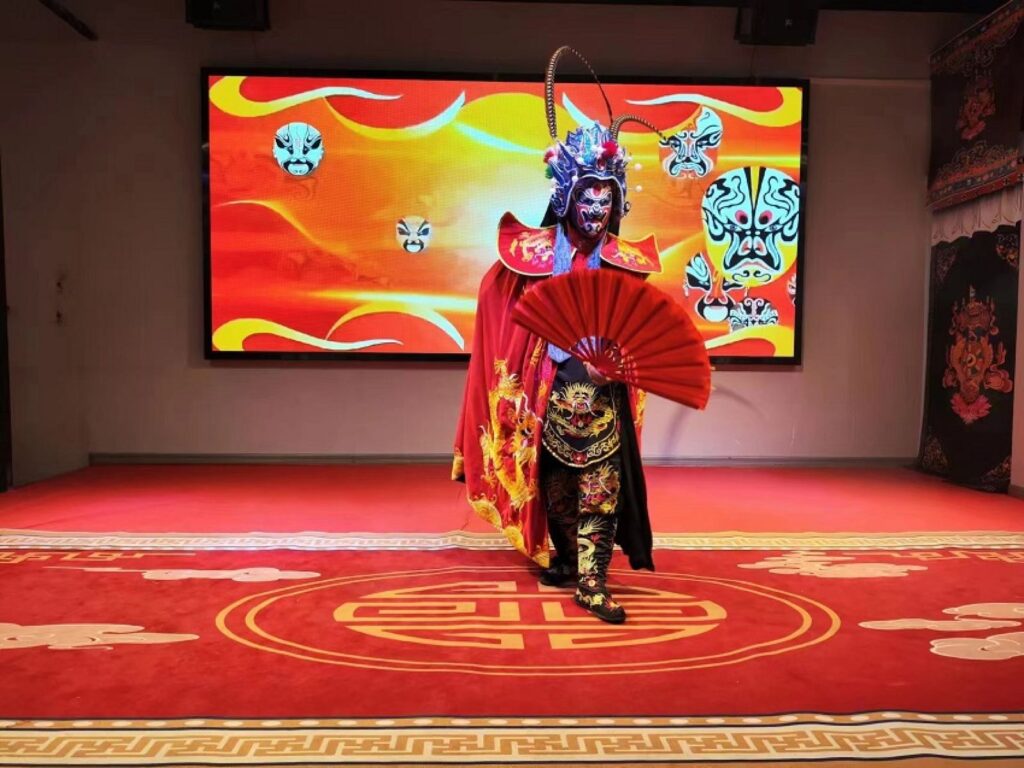1. Flowing Cloud Water Sleeves:
A water sleeve dance can captivate the whole city, and a tune is full of charm. The water sleeve is a section of white silk sewn on the cuffs of the actor’s costume. Performing with water sleeves means that actors use the water sleeves to make rich and choreographed movements. Sometimes it looks like clusters of flower tassels, sometimes like floating clouds and flowing water, and sometimes like wavy ripples.
2. Classical Dance “Ni Shang”:
Originating in ancient times, it is gentle, graceful and charming. The dancer wears a shawl like colorful clouds on the upper body, a skirt like a rainbow on the lower body, a “step-shaking crown” on the head, and jewelry made of beaded emeralds inserted on the crown, which trembles with each step. Wearing a neck ornament inlaid with golden flowers around the neck and embroidered belts with tinkling jade pendants on the body, the dancer spins and moves freely in front of the dance floor, as if a flying phoenix gently descends and a swimming dragon floats lightly. “Small downward hand gesture”, “Obliquely dragging the skirt” and “Wind sleeves rising and falling” are all kinds of dance postures.
3. Long-spouted Kettle Gongfu Tea Ceremony:
A copper kettle can reverse the world. The tea master uses a 1.2-meter copper kettle to integrate Chinese martial arts, dance, acrobatics and opera into the gongfu tea ceremony. Sometimes it circles above the head, sometimes winds around the waist, with ease and smoothness. The long-spouted kettle gongfu tea ceremony performance is not only a kind of tea art skill. During the performance, the tea master will also show his elegant hand gestures and the beauty of the body, allowing people to feel elegance and enjoyment while tasting tea. This kind of performance is very popular in China and even around the world. It represents the essence and cultural connotation of tea in traditional Chinese culture. In today’s fast-paced life, it has become one of the important ways for people to pursue nature and humanity.
4. Shadow Puppetry: “Wu Song Fights the Tiger” and “Pig Bajie Carries His Wife”:
Chinese shadow puppetry is made by processing animal skins into a semi-transparent state and then carving and coloring them. The carving and painting techniques emphasize delicate knife work and vivid shapes. The puppet figures are generally divided into several parts such as the head, body, and limbs, all in profile. The head is attached with a helmet, and the body and limbs are dressed. After being painted with oil paint, they are baked and flattened with a firebrick. During the performance, insert the head of the puppet figure into the body, connect the body with the limbs, and at the same time insert three bamboo sticks on the body and both hands to operate the performance. In addition to the character shapes, some stage props, tables, chairs and scenery shapes also need to be carved to cooperate with the performance of folk dramas. It is the earliest national drama in China. In China, shadow puppetry is known as the ancestor of all operas and is also the originator of world film, television and animation.
5. Sichuan Opera ‘Rolling the Lantern’: Also known as ‘Pi Jin Ding Deng’, it narrates a traditional Sichuan tale of a husband returning home to be ‘tidied up’ by his wife. This play artistically exaggerates snippets of life among the Shu people and incorporates the Sichuan Opera specialty ‘top-lantern’, becoming a distinctive performance that showcases skill, highly观赏able and entertaining. It is not only beloved by Sichuan audiences but also enjoys a great reputation nationwide and overseas. This Sichuan Opera clown play primarily expresses the respect and affection of men towards women, with the rolling of the lantern representing the exquisite skill, and the artistic inheritance conveying the sentiment of culture.
6. Sichuan Opera ‘Face Changing’: Sichuan Opera face changing is one of the special techniques used to reveal the inner emotions and thoughts of characters, transforming the invisible and intangible emotions into visible and tangible faces. It is a romantic technique to reveal characters’ inner thoughts in the drama. Face changing is an extraordinary skill in Sichuan Opera, originating in the 1930s and first used in the traditional play ‘Gui Zheng Lou’, where a chivalrous character named Bei Rong changes faces multiple times to save people, thus continuing this novel performance method.
Sichuan Opera’s ‘face changing’ is known as a ‘national treasure, unique skill, and spectacle’, and is generally not passed on externally. The methods of face changing can be broadly categorized into three types – wiping, blowing, and pulling. 7. ‘Spitting Fire’: A mysterious and unique skill in Sichuan Opera, originating from ancient Western Shu and famous in the Chinese opera circle, it is one of the exciting and distinctive performances in Sichuan Opera. Actors, with breath control and a slight adjustment of energy, can spit out a column of fire. The performance, with actors leaping and suddenly spitting out a fire dragon, is thrilling and exciting. It is a powerful and romantic artistic technique to display the dramatic changes in characters’ inner worlds and the plot, as well as their internal tension. The performance is open all year round from 09:30 to 21:30.

